The Indicators Tell Us...
As I opined yesterday morning, I believe stocks are in the midst of what is called a "bad news panic." Typically, such environments take hold when players are focused on a single event (or, in this case, a potential event) that appears to be negative. The bottom line is the situation creates fear and uncertainty. And if there is anything the stock market hates, it is fear and uncertainty.
The reason I preempted my weekly review of the indicators yesterday morning was I thought this was important information. I also wanted to point out that while stocks had been tanking on a daily, basis, some "good news" was bound to crop up eventually.
Right on cue, we got word that China and the U.S. are currently negotiating on trade. To be sure, this is good news since as long as both sides are talking, a "war" on trade is unlikely to take hold. And this was the reason for the Dow's 669 point gain, which, for the record, was the third biggest daily point gain in history (and no, this doesn't mean nearly as much today as it 20 years ago!).
Although my time is short this morning, I'd also like to point out that one-day does not a trend reverse and that a fair amount of technical damage has been done. Therefore, we should probably expect more "testing" and more volatility in the coming weeks.
In reviewing the market models and indicators, I came away with a familiar message this week and three key points. First, we need to remember that this is not a low risk environment. Second, the stars are starting to align for the bulls to make a meaningful rebound attempt. And third, the fundamental backdrop looks to be in pretty good shape.
Therefore, I continue to believe that the dips should be bought, that this remains an emotional market environment, and that the bulls deserve the benefit of the doubt from a big-picture perspective.
Publishing Note: I am vacationing the rest of the week and will publish reports only as needed.
Thought For The Day:
Don't wait. The time will never be just right. -Napoleon Hill
Wishing you green screens and all the best for a great day,

David D. Moenning
Founder, Chief Investment Officer
Heritage Capital Research
HCR Focuses on a Risk-Managed Approach to Investing
Must Read: What Risk Management Can and Cannot Do
HCR's Financial Advisor Services
HCR's Individual Investor Services
Questions, comments, or ideas? Contact Us
At the time of publication, Mr. Moenning held long positions in the following securities mentioned: None - Note that positions may change at any time.
The State of the Big-Picture Market Models
It's a new week, so let's start things off with a review of the state of my favorite big-picture market models, which are designed to tell us which team is in control of the prevailing major trend.
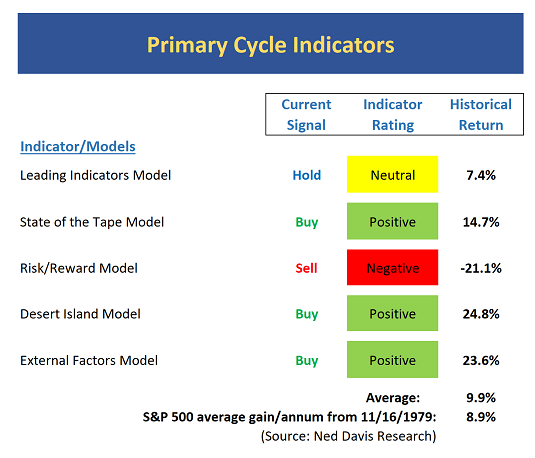
View My Favorite Market Models Online
Executive Summary:
- The long-term Leading Indicators model remains on a buy signal, but only by a slim margin.
- Our "State of the tape" model remains in good shape.
- The Risk/Reward model remains negative and on sell signal. As I've been saying, this is a warning flag.
- Despite the scary action last week, my "desert island" model (which combines trend, momentum, and external factors) remains on a buy signal and in pretty good shape - all things considered.
- The recently expanded External Factors model remains positive.
- The Primary Cycle board suggests that the backdrop for stocks remains solid.
The State of the Trend
Digging into the details, I like to start my weekly review with a look at the "state of the trend." These indicators are designed to give us a feel for the overall health of the current short- and intermediate-term trend models.
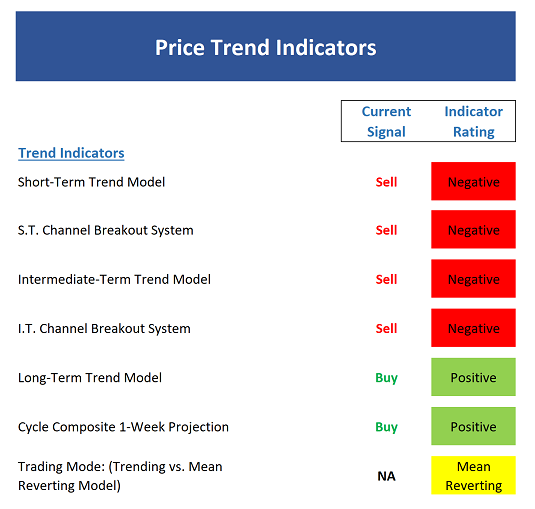
View Trend Indicator Board Online
Executive Summary:
- Despite Monday's bounce, the short-term trend of the stock market remains negative. However, the rebound does lend credence to the idea that a new trading range has been established.
- Another strong up day would cause the S.T. Channel Breakout System to improve. But for now, the indicator still suggests caution.
- The intermediate-term Trend Model is red to start the week, but a weekly close above 2750(ish) will flip this indicator back to green
- The intermediate-term Channel Breakout System remains on a sell signal. A close above 2760 is needed to produce a new buy signal this week.
- The long-term Trend Model remains positive and reminds us this is a bull market until proven otherwise.
- The Cycle Composite suggests an up and down week and down week that ends slightly ahead.
- From an intermediate-term perspective, the market remains in a mean-reverting mode.
The State of Internal Momentum
Next up are the momentum indicators, which are designed to tell us whether there is any "oomph" behind the current trend.
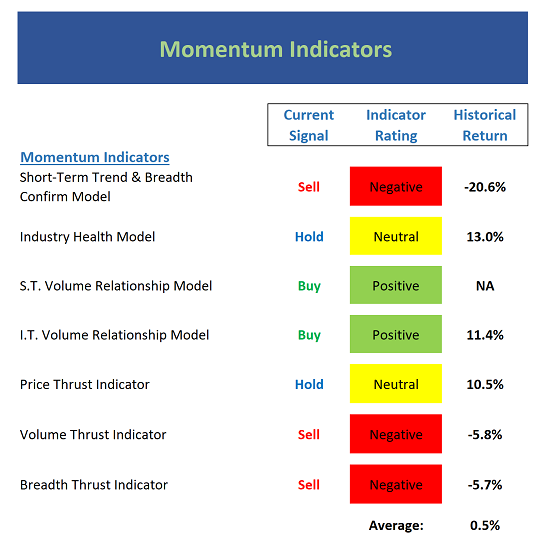
View Momentum Indicator Board Online
Executive Summary:
- The short-term Trend and Breadth Confirm Model flip-flopped again lasts week, moving from green to red.
- The Industry Health Model remains stuck in the neutral zone. However, it is interesting to note that this model did not flip to negative. This suggests the bulls may still have the edge.
- Strangely, the short-term Volume Relationship model remains positive here.
- The intermediate-term Volume Relationship Model remains positive. This is yet another reminder that the bulls should be given the benefit of any doubt.
- You can file this one in the "Captain Obvious" category, but the intermediate-term Price Thrust Indicator fell out of the positive zone last week.
- The Volume Thrust Indicator slipped to negative.
- The Breadth Thrust Indicator also moved into the red last week.
- The recent lack of momentum "oomph" causes us to worry that the recent rally had "failed." As such, we will continue to watch the momentum indicators closely here.
The State of the "Trade"
We also focus each week on the "early warning" board, which is designed to indicate when traders might start to "go the other way" -- for a trade.
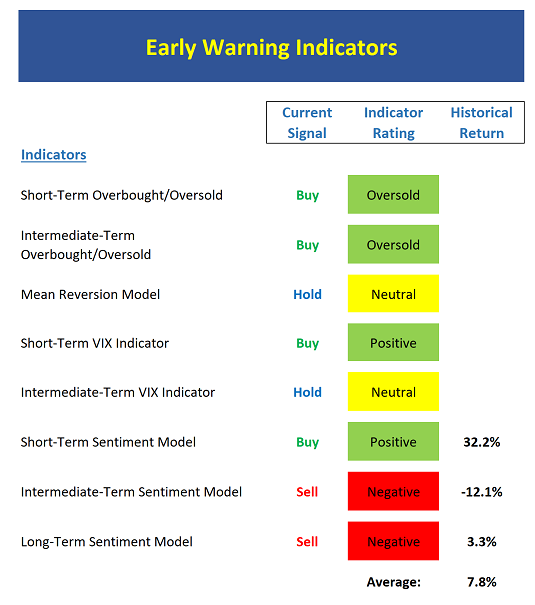
View Early Warning Indicator Board Online
Executive Summary:
- From a near-term perspective, stocks reached an oversold condition and have reversed, which triggers a near-term buy signal.
- From an intermediate-term view, stocks are now oversold as well. Thus, the cycles are now aligned.
- The Mean Reversion Model remains neutral.
- The short-term VIX indicator produced buy signal on Monday 3/26.
- Our longer-term VIX Indicator is also approaching a buy signal.
- From a short-term perspective, market sentiment has reversed and is now overly negative - which is a positive for the sentiment game.
- The intermediate-term Sentiment Model remains in the red zone to start the week.
- The Long-Term Sentiment Model also remains in the negative zone.
The State of the Macro Picture
Now let's move on to the market's "external factors" - the indicators designed to tell us the state of the big-picture market drivers including monetary conditions, the economy, inflation, and valuations.
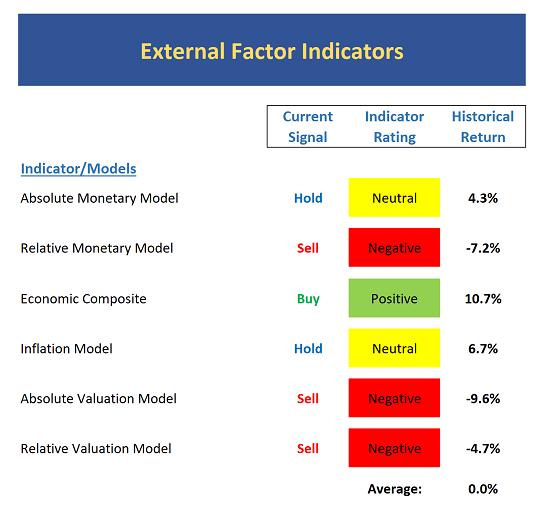
View External Factors Indicator Board Online
Executive Summary:
- The Absolute Monetary model continues to waffle around near the negative zone as of yet, has not yet produced a sell signal.
- The Relative Monetary Model remains negative and on a sell signal.
- The Economic Model continues to suggest a strong economic and stock market backdrop.
- The inflation model moved to neutral two weeks ago and suggests that inflation pressures are building.
- The Absolute Valuation model remains steadfastly negative.
- Our Relative Valuation Model is also negative.
- The External Factors board continues to warn that this is not a low risk environment.
Sample Tactical Allocation Model
Below is an EXAMPLE (and ONLY an EXAMPLE) of how one might incorporate the indicator boards. The approach shown below is designed to provide the current equity allocation for a balanced tactical asset allocation model with a base target of 60/40 stocks/bonds.
The overall intent of the model is to keep equity exposure in line with current conditions.
Beginning February 2018, the model will be updated monthly.
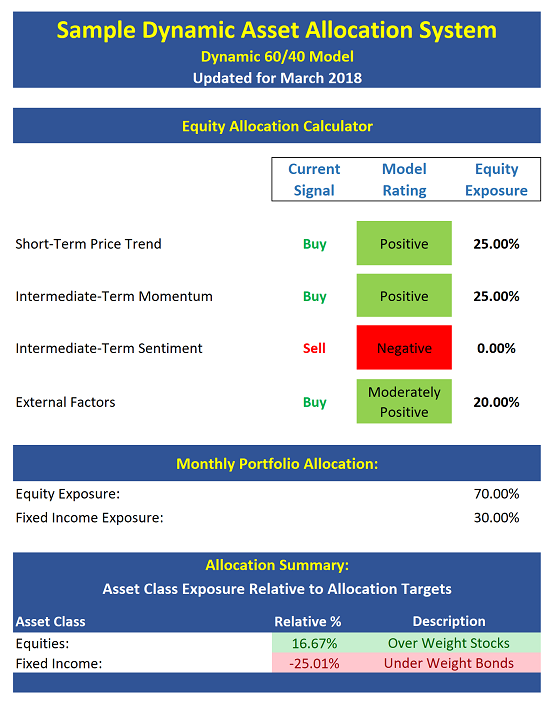
The model above is for illustrative and informational purposes only and does not in any way represent any investment recommendation. The model is merely a sample of how indicators can be grouped to create a guide to market exposure based on the inputs from multiple indicators/models.
Indicators Explained
Short-Term Trend-and-Breadth Signal Explained: History shows the most reliable market moves tend to occur when the breadth indices are in gear with the major market averages. When the breadth measures diverge, investors should take note that a trend reversal may be at hand. This indicator incorporates NDR's All-Cap Dollar Weighted Equity Series and A/D Line. From 1998, when the A/D line is above its 5-day smoothing and the All-Cap Equal Weighted Equity Series is above its 25-day smoothing, the equity index has gained at a rate of +32.5% per year. When one of the indicators is above its smoothing, the equity index has gained at a rate of +13.3% per year. And when both are below, the equity index has lost +23.6% per year.
Channel Breakout System Explained: The short-term and intermediate-term Channel Breakout Systems are modified versions of the Donchian Channel indicator. According to Wikipedia, "The Donchian channel is an indicator used in market trading developed by Richard Donchian. It is formed by taking the highest high and the lowest low of the last n periods. The area between the high and the low is the channel for the period chosen."
Intermediate-Term Trend-and-Breadth Signal Explained: This indicator incorporates NDR's All-Cap Dollar Weighted Equity Series and A/D Line. From 1998, when the A/D line is above its 45-day smoothing and the All-Cap Equal Weighted Equity Series is above its 45-day smoothing, the equity index has gained at a rate of +17.6% per year. When one of the indicators is above its smoothing, the equity index has gained at a rate of +6.5% per year. And when both are below, the equity index has lost -1.3% per year.
Industry Health Model Explained: Designed to provide a reading on the technical health of the overall market, Big Mo Tape takes the technical temperature of more than 100 industry sectors each week. Looking back to early 1980, when the model is rated as "positive," the S&P has averaged returns in excess of 23% per year. When the model carries a "neutral" reading, the S&P has returned over 11% per year. But when the model is rated "negative," stocks fall by more than -13% a year on average.
Cycle Composite Projections: The cycle composite combines the 1-year Seasonal, 4-year Presidential, and 10-year Decennial cycles. The indicator reading shown uses the cycle projection for the upcoming week.
Trading Mode Indicator: This indicator attempts to identify whether the current trading environment is "trending" or "mean reverting." The indicator takes the composite reading of the Efficiency Ratio, the Average Correlation Coefficient, and Trend Strength models.
Volume Relationship Models: These models review the relationship between "supply" and "demand" volume over the short- and intermediate-term time frames.
Price Thrust Model Explained: This indicator measures the 3-day rate of change of the Value Line Composite relative to the standard deviation of the 30-day average. When the Value Line's 3-day rate of change have moved above 0.5 standard deviation of the 30-day average ROC, a "thrust" occurs and since 2000, the Value Line Composite has gained ground at a rate of +20.6% per year. When the indicator is below 0.5 standard deviation of the 30-day, the Value Line has lost ground at a rate of -10.0% per year. And when neutral, the Value Line has gained at a rate of +5.9% per year.
Volume Thrust Model Explained: This indicator uses NASDAQ volume data to indicate bullish and bearish conditions for the NASDAQ Composite Index. The indicator plots the ratio of the 10-day total of NASDAQ daily advancing volume (i.e., the total volume traded in stocks which rose in price each day) to the 10-day total of daily declining volume (volume traded in stocks which fell each day). This ratio indicates when advancing stocks are attracting the majority of the volume (readings above 1.0) and when declining stocks are seeing the heaviest trading (readings below 1.0). This indicator thus supports the case that a rising market supported by heavier volume in the advancing issues tends to be the most bullish condition, while a declining market with downside volume dominating confirms bearish conditions. When in a positive mode, the NASDAQ Composite has gained at a rate of +38.3% per year, When neutral, the NASDAQ has gained at a rate of +13.3% per year. And when negative, the NASDAQ has lost at a rate of -8.5% per year.
Breadth Thrust Model Explained: This indicator uses the number of NASDAQ-listed stocks advancing and declining to indicate bullish or bearish breadth conditions for the NASDAQ Composite. The indicator plots the ratio of the 10-day total of the number of stocks rising on the NASDAQ each day to the 10-day total of the number of stocks declining each day. Using 10-day totals smooths the random daily fluctuations and gives indications on an intermediate-term basis. As expected, the NASDAQ Composite performs much better when the 10-day A/D ratio is high (strong breadth) and worse when the indicator is in its lower mode (weak breadth). The most bullish conditions for the NASDAQ when the 10-day A/D indicator is not only high, but has recently posted an extreme high reading and thus indicated a thrust of upside momentum. Bearish conditions are confirmed when the indicator is low and has recently signaled a downside breadth thrust. In positive mode, the NASDAQ has gained at a rate of +22.1% per year since 1981. In a neutral mode, the NASDAQ has gained at a rate of +14.5% per year. And when in a negative mode, the NASDAQ has lost at a rate of -6.4% per year.
Short-Term Overbought/sold Indicator: This indicator is the current reading of the 14,1,3 stochastic oscillator. When the oscillator is above 80 and the %K is above the %D, the indicator gives an overbought reading. Conversely, when the oscillator is below 20 and %K is below its %D, the indicator is oversold.
Intermediate-Term Overbought/sold Indicator: This indicator is a 40-day RSI reading. When above 57.5, the indicator is considered overbought and when below 45 it is oversold.
Mean Reversion Model: This is a diffusion model consisting of five indicators that can produce buy and sell signals based on overbought/sold conditions.
VIX Indicator: This indicator looks at the current reading of the VIX relative to standard deviation bands. When the indicator reaches an extreme reading in either direction, it is an indication that a market trend could reverse in the near-term.
Short-Term Sentiment Indicator: This is a model-of-models composed of 18 independent sentiment indicators designed to indicate when market sentiment has reached an extreme from a short-term perspective. Historical analysis indicates that the stock market's best gains come after an environment has become extremely negative from a sentiment standpoint. Conversely, when sentiment becomes extremely positive, market returns have been subpar.
Intermediate-Term Sentiment Indicator: This is a model-of-models composed of 7 independent sentiment indicators designed to indicate when market sentiment has reached an extreme from an intermediate-term perspective. Historical analysis indicates that the stock market's best gains come after an environment has become extremely negative from a sentiment standpoint. Conversely, when sentiment becomes extremely positive, market returns have been subpar.
Long-Term Sentiment Indicator: This is a model-of-models composed of 6 independent sentiment indicators designed to indicate when market sentiment has reached an extreme from a long-term perspective. Historical analysis indicates that the stock market's best gains come after an environment has become extremely negative from a sentiment standpoint. Conversely, when sentiment becomes extremely positive, market returns have been subpar.
Absolute Monetary Model Explained: The popular cliché, "Don't fight the Fed" is really a testament to the profound impact that interest rates and Fed policy have on the market. It is a proven fact that monetary conditions are one of the most powerful influences on the direction of stock prices. The Absolute Monetary Model looks at the current level of interest rates relative to historical levels and Fed policy.
Relative Monetary Model Explained: The "relative" monetary model looks at monetary indicators relative to recent levels as well as rates of change and Fed Policy.
Economic Model Explained: During the middle of bull and bear markets, understanding the overall health of the economy and how it impacts the stock market is one of the few truly logical aspects of the stock market. When our Economic model sports a "positive" reading, history (beginning in 1965) shows that stocks enjoy returns in excess of 21% per year. Yet, when the model's reading falls into the "negative" zone, the S&P has lost nearly -25% per year. However, it is vital to understand that there are times when good economic news is actually bad for stocks and vice versa. Thus, the Economic model can help investors stay in tune with where we are in the overall economic cycle.
Inflation Model Explained: They say that "the tape tells all." However, one of the best "big picture" indicators of what the market is expected to do next is inflation. Simply put, since 1962, when the model indicates that inflationary pressures are strong, stocks have lost ground. Yet, when inflationary pressures are low, the S&P 500 has gained ground at a rate in excess of 13%. The bottom line is inflation is one of the primary drivers of stock market returns.
Valuation Model Explained: If you want to get analysts really riled up, you need only to begin a discussion of market valuation. While the question of whether stocks are overvalued or undervalued appears to be a simple one, the subject is extremely complex. To simplify the subject dramatically, investors must first determine if they should focus on relative valuation (which include the current level of interest rates) or absolute valuation measures (the more traditional readings of Price/Earnings, Price/Dividend, and Price/Book Value). We believe that it is important to recognize that environments change. And as such, the market's focus and corresponding view of valuations are likely to change as well. Thus, we depend on our Valuation Models to help us keep our eye on the ball.
Disclosures
The opinions and forecasts expressed herein are those of Mr. David Moenning and may not actually come to pass. Mr. Moenning's opinions and viewpoints regarding the future of the markets should not be construed as recommendations. The analysis and information in this report is for informational purposes only. No part of the material presented in this report is intended as an investment recommendation or investment advice. Neither the information nor any opinion expressed constitutes a solicitation to purchase or sell securities or any investment program.
Any investment decisions must in all cases be made by the reader or by his or her investment adviser. Do NOT ever purchase any security without doing sufficient research. There is no guarantee that the investment objectives outlined will actually come to pass. All opinions expressed herein are subject to change without notice. Neither the editor, employees, nor any of their affiliates shall have any liability for any loss sustained by anyone who has relied on the information provided.
Mr. Moenning may at times have positions in the securities referred to and may make purchases or sales of these securities while publications are in circulation. Positions may change at any time.
The analysis provided is based on both technical and fundamental research and is provided "as is" without warranty of any kind, either expressed or implied. Although the information contained is derived from sources which are believed to be reliable, they cannot be guaranteed.
Investments in equities carry an inherent element of risk including the potential for significant loss of principal. Past performance is not an indication of future results.
